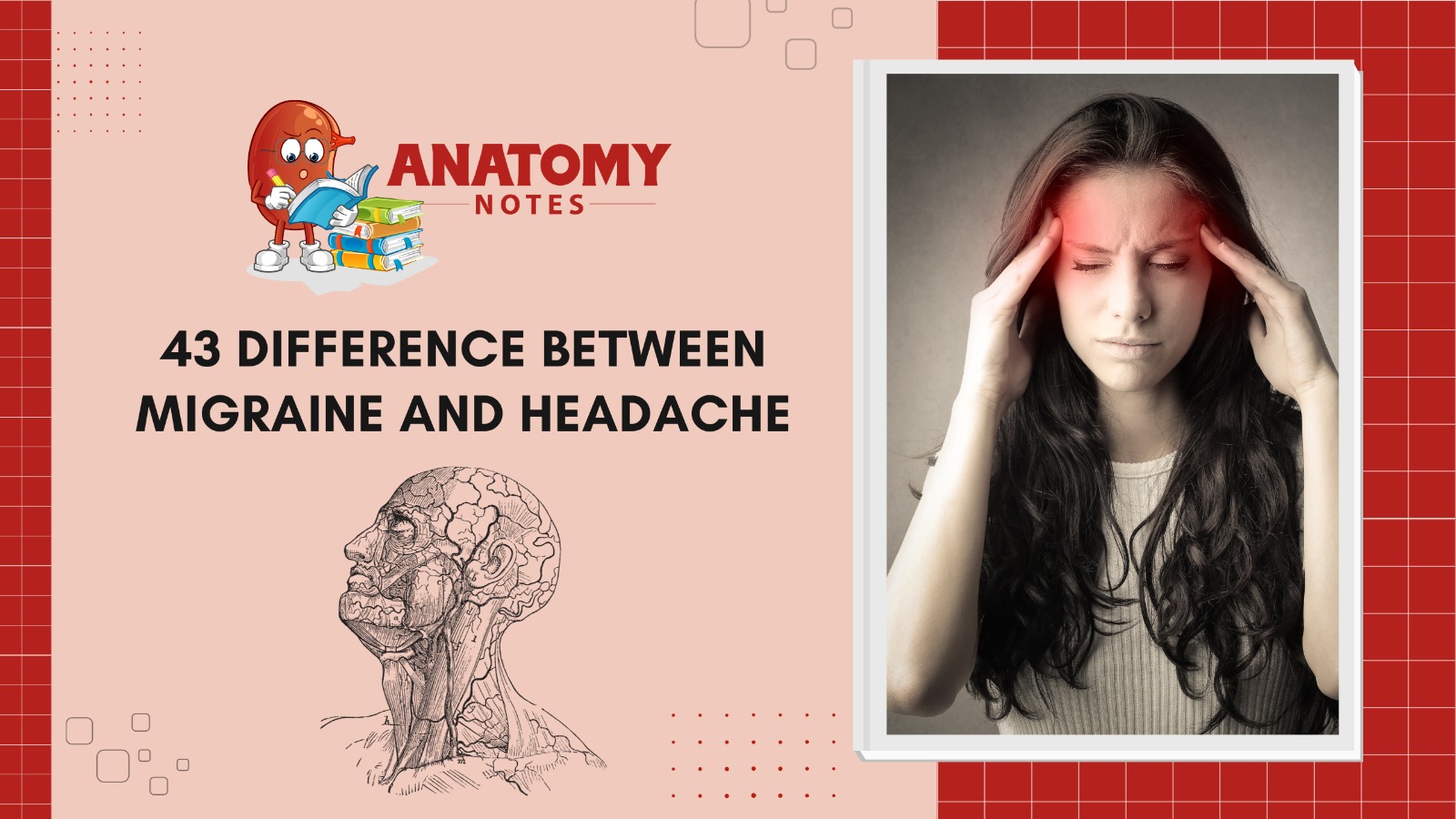Each head sickness has its own symptoms and peculiarities, however, migraine and headaches are often misinterpreted. Diagnosis and therapy need to understand their differences. Migraines are complex neurological illnesses that produce frequent, intense, throbbing head pain on one side. Migraines cause nausea, vomiting, light and sound sensitivity. Some people get auras, which are flashing lights or blind patches before migraines. Migraines can last hours or days and impair life.
However, headaches are any head or upper neck discomfort. Strength, duration, and origin vary from headaches. The most common are tension headaches. Stress or worry generates this dull, chronic headache on both sides of the head. Cluster headaches, on the other hand, are painful, cyclical headaches on one side.
Another difference between migraines and headaches is triggers. Stress, lack of sleep, dehydration, and medical concerns can cause headaches, but meals, hormone swings, weather changes, and strong odors induce migraines.
Migraines and headaches are treated differently. Over-the-counter medications like ibuprofen or acetaminophen can cure mild to moderate headaches, but severe or persistent headaches may require prescription drugs. Migraines require particular medications to prevent or cure. Anti-nausea, triptans, and preventatives are examples.
In conclusion, migraines and headaches cause head pain but have diverse causes, symptoms, and treatments. Tension and stress generate headaches, but migraines are more severe, have specific triggers, and have several symptoms. Separation is necessary for effective treatment of many severe disorders. Significant head pain requires medical evaluation and treatment.
Here are 43 differences between migraines and headaches in a table format:
|
S.No. |
Aspects |
Migraine |
Headache |
|
1 |
Type |
Symptom or a symptom of various conditions |
|
|
2 |
Pain Severity |
Severe and throbbing pain |
Mild to moderate pain |
|
3 |
Duration |
Lasts for hours to days |
Typically shorter duration (minutes to hours) |
|
4 |
Frequency |
Less frequent, often episodic |
Can be occasional or chronic |
|
5 |
Location |
Often one-sided, can switch sides |
May affect both sides of the head or be localized |
|
6 |
Associated Symptoms |
Nausea, vomiting, aura (visual disturbances), sensitivity to light and sound |
Fewer associated symptoms |
|
7 |
Triggers |
Specific triggers like certain foods, stress, hormonal changes |
May have triggers but often not as specific |
|
8 |
Aura |
Some migraines have an aura (visual or sensory disturbances) |
Headaches typically do not have an aura |
|
9 |
Family History |
Often a family history of migraines |
May or may not have a family history of headaches |
|
10 |
Prodrome |
Pre-headache phase with symptoms like mood changes, food cravings |
May have mild warning signs or prodrome |
|
11 |
Response to Pain Relievers |
Migraines may respond to specific migraine medications |
Headaches may respond to over-the-counter pain relievers |
|
12 |
Triggers Commonly Recognized |
Specific triggers like certain foods, stress, hormonal changes |
Triggers may vary widely depending on the cause |
|
13 |
Hormonal Influence |
Often influenced by hormonal changes, particularly in women |
Typically less influenced by hormonal changes |
|
14 |
Vision Changes |
May have visual disturbances during an aura |
Generally no visual disturbances |
|
15 |
Aura Duration |
Aura typically lasts less than an hour |
No aura or visual disturbances |
|
16 |
Aura Frequency |
Aura may occur before or during a migraine |
No aura or visual disturbances with headaches |
|
17 |
Sound and Light Sensitivity |
Hypersensitivity to sound and light is common |
Hypersensitivity to sound and light can vary |
|
18 |
Debilitating |
Can be debilitating, affecting daily activities |
Generally less debilitating and easier to manage |
|
19 |
Presence of Triggers |
Triggers often play a significant role |
Triggers may be present but not always identified |
|
20 |
Nausea and Vomiting |
Nausea and vomiting are common |
Less common but can occur |
|
21 |
Affects Quality of Life |
Can significantly impact quality of life |
Typically has a milder impact on daily life |
|
22 |
Commonly Confused With |
Sometimes confused with tension-type headaches |
Less commonly confused with migraines |
|
23 |
Neurological Symptoms |
May experience neurological symptoms like tingling or numbness |
Typically no neurological symptoms |
|
24 |
Sleep Patterns |
Migraines may disrupt sleep patterns |
Headaches may cause discomfort but less likely to disrupt sleep |
|
25 |
Food Triggers |
Specific foods may trigger migraines in some individuals |
Food triggers are less commonly reported |
|
26 |
Stress as a Trigger |
Stress is a common trigger for migraines |
Stress can trigger both migraines and headaches |
|
27 |
Muscle Tension |
May experience muscle tension in the neck and shoulders |
Muscle tension may cause tension-type headaches |
|
28 |
Associated Symptoms in Children |
Children may experience abdominal migraines |
Children may have different headache types |
|
29 |
Medication Overuse Headache |
Overuse of pain relievers can lead to medication overuse headaches |
Less likely to develop medication overuse headaches |
|
30 |
Hormonal Migraines (Women) |
Some women experience menstrual migraines |
Hormonal headaches can also affect women |
|
31 |
Sleep Quality |
Migraines may affect sleep quality |
Headaches may disrupt sleep but often less severely |
|
32 |
Pediatric Considerations |
Pediatric migraines may be accompanied by abdominal symptoms |
Pediatric headaches can vary in type and presentation |
|
33 |
Diagnosis |
Diagnosed based on specific criteria and patient history |
Diagnosis based on clinical evaluation and patient history |
|
34 |
Triggers in Children |
Children may have different migraine triggers |
Children may have various headache triggers |
|
35 |
Pulsating Pain |
Often characterized by pulsating or throbbing pain |
Pulsating pain is less common in tension-type headaches |
|
36 |
Response to Triptans |
Triptans are often effective in relieving migraines |
Triptans may not be as effective for tension-type headaches |
|
37 |
Symptom Clusters |
Migraines have specific symptom clusters |
Headaches may present with diverse symptoms |
|
38 |
Chronic Forms |
Chronic migraines may occur (15 or more headache days per month) |
Chronic daily headaches are a distinct category |
|
39 |
Preventive Medications |
Often prescribed preventive medications for frequent migraines |
Preventive medications are less commonly used for headaches |
|
40 |
Variability in Symptoms |
Symptoms and severity can vary from one migraine to another |
Headache symptoms may vary but are generally more consistent |
|
41 |
Psychological Impact |
May have a greater psychological impact |
May have a milder psychological impact |
|
42 |
Prodrome Symptoms in Children |
Children may experience prodrome symptoms like mood changes |
Prodrome symptoms in children are less common |
|
43 |
Treatment Approach |
Treatment often includes migraine-specific medications |
Treatment may involve over-the-counter pain relievers and lifestyle changes |
Also read: 29 Difference between Heat Stroke and Heat Exhaustion
Frequently Asked Questions (FAQ’s):
Q1. What distinguishes migraines from headaches?
A migraine is a neurological condition that causes strong, throbbing head pain on one side nausea, vomiting, and light and sound sensitivity. A headache, on the other hand, is any head or upper neck pain, typically without these symptoms. Migraines can be more debilitating than headaches.
Q2. Can headaches cause migraines or vice versa?
While headaches and migraines are different, regular tension-type headache sufferers may develop migraines. Some migraines start with a tension-type headache before becoming migraine-like. Few people get both disorders, and many only have one.
Q3. What causes most migraines and headaches?
Headaches can be caused by stress, lack of sleep, dehydration, and medical issues. Certain foods (old cheeses, chocolate), hormone shifts, weather changes, and strong scents might provoke migraines. Trigger identification and avoidance are crucial to controlling both disorders.
Q4. Are migraines and headaches handled differently?
The intensity and kind of disease determine treatment. Over-the-counter painkillers like ibuprofen or acetaminophen help ease headaches. Prescription drugs may be needed for severe headaches. Triptans, anti-nausea medicines, and migraine preventives are needed to treat migraines. Migraine management requires lifestyle adjustments, stress management, and trigger avoidance.
Q5. When should I visit a doctor for a headache or migraine?
If you suffer any of these, get medical attention:
1.Urgent, strong headache, especially if it’s different from typical.
2.Headaches that increase or cause neurological symptoms including weakness, disorientation, or speech problems.
3.Headaches that persist or resist over-the-counter treatments.
4.Frequent or severe migraines that disrupt your life.
5.Headache or migraine symptoms that are peculiar.




